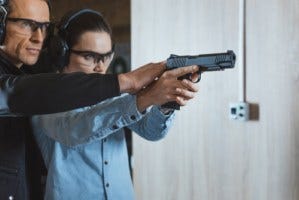Opinion | A Gun in the Home Makes Murder More Likely, Not Less
The New York Times · by Nicholas Kristof · April 22, 2023
Nicholas Kristof
In most of the world, going to the wrong house is not a deadly risk.
But in the United States it is, because we’re awash in an estimated 450 million guns and suffer from a mass delusion that a gun in the home makes us safer.
We’re caught in a spiral in which perceptions of rising crime lead more people to purchase firearms — about 60 million guns have been sold in the United States just since 2020 — and this in turn leads to more gun violence, which leads to more fear and gun purchases …. You get the idea.
So we have recent tragedies:
— In Kansas City, Mo., a Black 16-year-old was shot twice, in the forehead and an arm, when he went to the wrong house to pick up his younger brothers; he is recovering from a traumatic brain injury. The 84-year-old white man who, according to the prosecutor, shot him through a glass front door has been charged with first-degree assault; the man said he thought the boy was breaking into his home.
— In upstate New York, a 20-year-old woman was killed when she and several friends drove to the wrong address. As their car was turning around to leave, the homeowner allegedly fired his gun and struck her.
— In Texas, two cheerleaders were shot after one of them mistakenly got into the wrong car in a parking lot. One of the girls, age 18, was hit in the back and a leg and taken by helicopter to a hospital; she was initially reported to be in critical condition.
Elsewhere, brutes send their victims to the E.R.; in America, they send them to their graves.
Foreigners admire our popular culture, our technology, our lifestyle, but are bewildered by our refusal to rein in guns.
In the 1990s when I was Tokyo bureau chief of The Times, Japanese people regularly spoke to me about a 1992 incident in which a 16-year-old Japanese exchange student, Yoshihiro Hattori, was shot dead in Louisiana after knocking on the wrong door. The homeowner said he thought the boy was a burglar and ordered him to “freeze”; Hattori perhaps didn’t understand “freeze” or misheard the man as saying “please.” In any case, the boy moved, and the man shot him with a .44 magnum.
In Japan, where fewer people are murdered with guns in a typical year than sometimes in a single mass shooting in America, the government later prepared a booklet for Japanese people traveling to the United States with helpful English travel phrases like “freeze” and “hands in the air.”
“We are more civilized,” a Japanese professor told The Times after the incident, and she had a point.
We’re not going to ban guns or eliminate gun deaths in America. But I’ve argued in a longer essay that common-sense gun measures could plausibly reduce the toll of gun deaths by one-third or more.
We can adopt universal background checks, safe storage requirements, a minimum age of 21 for private gun sales and an enforced ban on possession of guns by people with a history of stalking or violent misdemeanors.
All states should adopt California’s successful experiment with background checks for buying ammunition; having instituted a number of smart gun measures, California now has a gun death rate 38 percent below the national average.
As I write this, I happen to be in Mississippi, which has a much more rigorous process to adopt a dog than to acquire a gun. Should it really be easier to buy an AR-15-style rifle than to adopt a Chihuahua?
Above all, we must challenge the misperception that a gun in the home makes people safer. Yes, on rare occasions, a gun can avert a crime. But researchers have found repeatedly that a gun in the house makes people more likely to be murdered, not less. “People living in homes with firearms have higher risks for dying by homicide,” according to a 2022 study in the Annals of Internal Medicine.
People may choose to have firearms for hunting or target practice or to protect livestock from predators (I live on a farm with guns), but given the elevated risk, personal safety is not a good reason to acquire a gun.
We might encourage homeowners who feel unsafe to get bear spray instead of a gun. As a backpacker, I carry bear spray in grizzly country because it’s more effective than a handgun at stopping one of these bears if it charges; the same may be true of stopping a home invader, and certainly the consequences of a mistake aren’t deadly.
Because of our complacency, the leading cause of death for children and teenagers in the United States is now gun violence, eclipsing vehicle crashes. In 2020, more than 4,300 young people died in America from firearms; the figure in the Netherlands for 2019 was two. At this rate, it will take a couple of millenniums for the Netherlands to lose as many kids to guns as we do annually.
We accept inconveniences when driving vehicles — seatbelts, infant seats, no one in the back of pickup trucks — because these can help us save lives. Why aren’t we similarly willing to accept safe storage or universal background checks for ammunition for the same reason?
I think of these young people shot simply because they went to the wrong place, and I think: If only we loved our children as much as we love our guns.
The Times is committed to publishing a diversity of letters to the editor. We’d like to hear what you think about this or any of our articles. Here are some tips. And here’s our email: letters@nytimes.com.
The New York Times · by Nicholas Kristof · April 22, 2023





